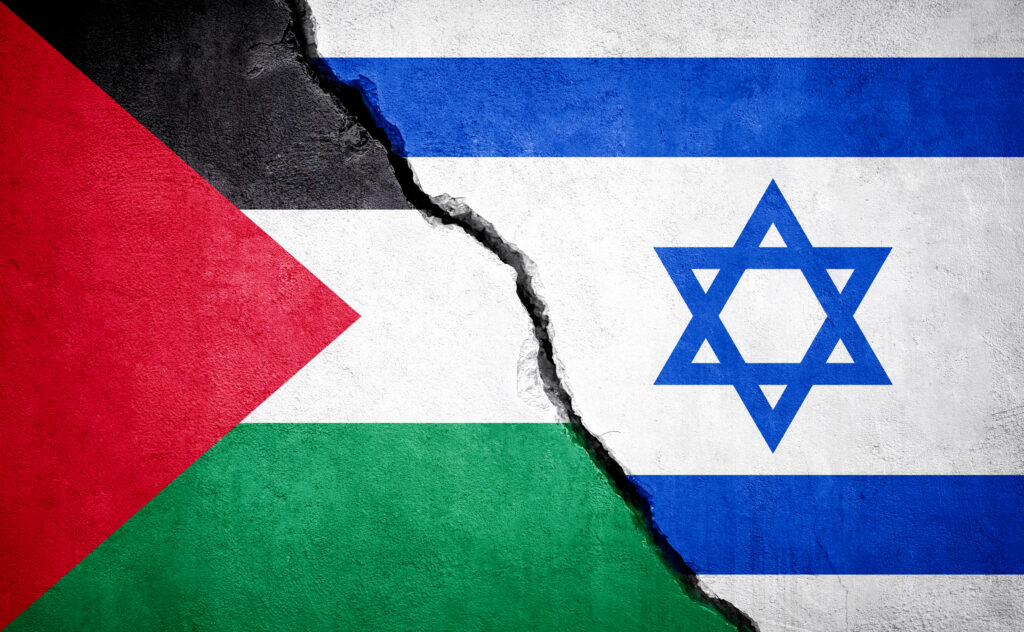The weight of the Paletsintine-Isreal conflict has left nearly every person affected. Under the weight of war and genocide, we are left with a deep sense of shared pain and anguish. When we collectively feel the pain of human suffering, some of us can experience emotional and psychological paralysis. Others experience anger and a desire for swift action. And still others avoid the pain in an effort to survive in our personal orbit. None of these personal responses are right or wrong–they reflect our personal history and social-cultural fabric.
At this time, it is a natural inclination to find comfort and relief in human connection. At Hyphens and Spaces, we exist to create environments for individuals, communities, and organizations, to hold space for healing and growth. We know that facilitating conversations on this issue is challenging AND we know that often the most difficult conversations are the most important to have. Here’s a step-by-step guide to help you navigate these discussions with care and intention:

Step 1: Consider whether you SHOULD have a conversation
People are seeking spaces to reflect, to emote, to grieve, to understand, and to gather in collective action. Organizations can play a critical role in facilitating some of those spaces. At Hyphens and Spaces, our perspective is that organizations should comment and act on social-political topics relative to how the issue impacts the organizational mission, values, and constituents. For example, a media company may issue a statement focused on fair and balanced coverage of the conflict, and then offer a working session with staff on how to manage their biases in reporting. An academic non-profit may issue a statement on intellectual freedom and offer resources to academics who feel that those freedoms are compromised. In addition to Palestinians and Israelis, what is unfolding has daily implications for Muslims, Jews, Arabs, survivors of war, and survivors of genocide. Consider who is in your sphere of influence and how you might support all who are impacted. Ask yourself these questions before committing to holding a conversation.
- Is this targeted and tailored to the needs of a specific community or stakeholder group in our orbit (e.g. Jewish staff members, Muslim students, members who are in leadership roles, etc.)?
- Is holding this conversation the best expression of our organization’s values of equity, justice, and inclusion?
- Have we received input from diverse stakeholders on how best to implement this?
- Does this provide benefit to those in our organizational orbit who are most impacted?
- Can we create the capacity to respond to stakeholders who share feedback about this conversation?
- Are we prepared to assume the risks and costs that come with having this conversation because the benefit outweighs that risk?
If you can answer yes to all of these questions, a conversation may be an appropriate action. If not, reconsider which action(s) would enable you to answer yes to all of the above questions.

Step 2: Clarify Your Intentions
When you invite people to a potentially charged conversation, you can demonstrate care for them by stating your intentions and goals clearly. Consider the needs of the communities or groups you aim to serve and what type of conversation would be beneficial to them. This punctuates the importance of receiving stakeholder input as it helps clarify needs. The most common motivations for holding conversation are:
- To create a space for emotional processing
- To provide education, background, or context
- To persuade others to see a particular viewpoint
- To build connections with others who have different viewpoints
- To share information, resources, or services
Your intention will shape the conversation and guide your approach. Be mindful not to conflate these motivations or let other motivations creep into the conversation. If your goal is to hold space for emotions, in a 60-minute session, it becomes counterproductive to have someone speaking for 20 minutes on the geo-political implications of US involvement with Israel. Know your intention, so that you can stay on track, and keep your audience aligned with the expectations.

Step 3: Select the appropriate forum and facilitator
With an emotionally charged topic, smaller (e.g. 1-1) conversations and interactions provide the greatest opportunity for tailoring, meeting individual needs, and building connections. Whenever possible, start there. As you move to group conversations ensure that the format (e.g. virtual, in-person, webinar, roundtable, audience participation, etc.) aligns with the intention you set in Step 2. For example, conversations focused on emotional processing, it’s beneficial to conduct these discussions within affinity groups (i.e. groups where participants have some shared identity or belief they depart from) formed with straightforward guiding questions and parameters. This allows participants to explore their experiences and perspectives within a psychologically safe and one that prioritizes emotional expression over critique of ideas. Affinity-based conversations are best when led by facilitators who share that affinity.
Ensure your conversation facilitators have the authority and skill to maintain boundaries within the conversation and navigate multiple viewpoints with emotional regulation. It is okay, as a facilitator to have a perspective and to make that perspective known. However, the facilitator should communicate how their perspective will or will not filter into their facilitation while simultaneously minimizing their emotional charge and reactivity.
Step 4: Set Clear Parameters
Establishing parameters for the conversation includes communicating what you will talk about, what you won’t talk about, and HOW it will be talked about. These parameters may include a combination of actions, (e.g. refraining from name-calling and undermining another person’s perspective, active listening, etc.), and states of being (being curious, empathetic, and humble). Ensure there is shared airtime for participants with differing viewpoints and opportunities for group and individual reflections.

Step 5: Cultivate Psychological Safety
Creating an environment where everyone feels safe to take risks is really important in these discussions. It’s crucial that all participants can express their thoughts without worrying about negative consequences, as long as they follow the guidelines we set at the beginning. This helps people feel secure and encourages open conversation. Strategies to encourage conversation among participants with diverse backgrounds and needs include balancing non-verbal communication, anonymous posting, small group discussions, and 1-1 conversations amidst larger group-wide conversations.
When we establish those guidelines, we should also be clear about what happens if someone crosses those boundaries. For instance, if someone threatens another participant, not only will they be asked to leave the conversation, but HR might look into it as a potential harassment issue. Being upfront about these things, even if they seem like common sense, actually helps everyone feel safer and better able to make informed choices.
Step 6: Remain human-centered
Your conversations should be exemplars of what you would hope for the world. The primary benefits of holding conversations versus posting virtually, are human connection, holding people accountable for how they engage with others, and the continuous exchange of ideas.
In all conversations, remember the human suffering associated with the conflict. Approach discussions with empathy and respect for those who have experienced loss, regardless of your own stance. Before moving into any debate over ideas, mindfully acknowledge the pain and loss experienced by those directly affected as well as those feeling the residual effects of islamophobia, anti-semitism, ethnocentrism, and racism.

Step 7: Take Action
Each of us has some power in our sphere of influence to transform our emotions and thoughts into action. Ultimately, the best that many of us can do is to channel the discussions and our emotions into actions that can benefit those most affected by the conflict. Support charitable causes, volunteer, or advocate for resolution.
This guide is an effort to provide some ease in decision-making amidst an uneasy time. For more information, we invite you to connect with us at Hyphens and Spaces, by booking an appointment with one of our consultants or emailing us at [email protected].


